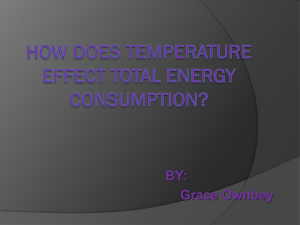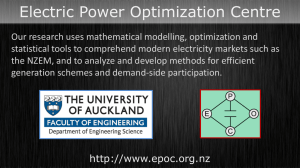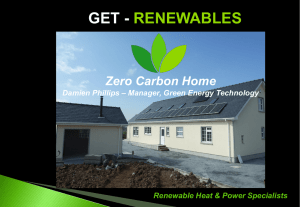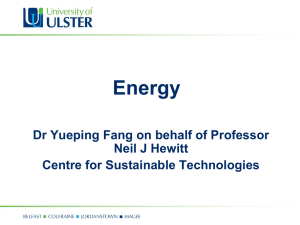Division of Energy Systems at Linköping University
advertisement
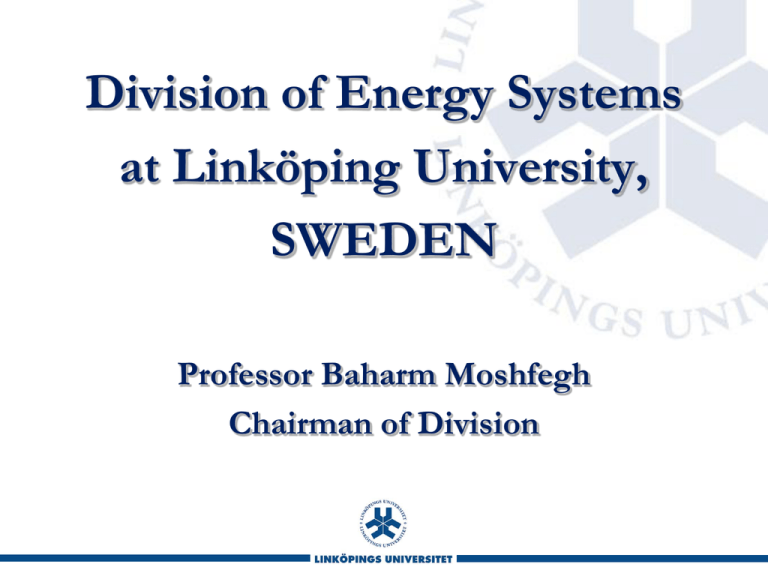
Division of Energy Systems at Linköping University, SWEDEN Professor Baharm Moshfegh Chairman of Division Division of Energy Systems • Established in 1980 • Belong to the Department of Management and Engineering • 25 Employees • 16 Active PhD students are registered today • 55 Academic theses • >400 Scientific articles in journals and proceedings of international conferences • >100 Master theses • Thousands of students have read the division's courses Definition of Energy Systems Energy systems consist of technical artefacts and processes as well as actors, organizations and institutions which are linked together in the conversion, transmission, management and utilization of energy. The view of energy as a Socio-technical system implies that also knowledge, practices and values must be taken into account to understand the on-going operations and processes of change in such systems. Levels of the Energy Systems • • • • • • Global energy systems National energy systems Regional energy systems Local energy systems Industrial energy systems Building as an energy system Sources, transport, resources, distribution, history-future, policy, rules, etc. Energy Systems Interplay, analysis and optimisation of energy supply, use and conservation Many possibilities to satisfy energy demand Hydropower Nuclear power Global fuel market Coal Natural gas Waste Wasted heat Condensing power plants Combined Heat and Power plants Electricity distribution District heating network Industrial manufacturing Electricity / fuel / heat possible Space heating, hot tap water Industrial heating Biofuel Waste heat from industries Electricity required Lighting Electric appliances etc Wind power Solar cells Energy demand Utilised heat Absorption refrigeration Space cooling District cooling network Enhanced coal utilisation • Increasing energy demand makes coal more valuable. • Better coal use in an efficient CHP plant that uses the heat than in a condensing plant that wastes the heat • If the heat is used: Less coal needed to satisfy energy demand Lower CO2 emissions caused by satisfying energy demand Incomes from electricity and heat sales, which may reduce electricity price Condensing power plant and Combined Heat and Power plant 100 90 80 70 Losses Utilised heat Electricity 60 50 40 30 20 10 0 Coal Condensing power plant CHP plant Combined Heat and Power plant Electricity CHP plant Absorption process Domestic hot water District heating Space cooling District cooling Space heating Process cooling for industry Steam for industry Sustainable electricity utilisation • Electricity is valuable • Minimised electricity consumption • Heat can be used instead of electricity in many cases, e.g. for heating and cooling. • Heat from combined heat and power (CHP) plants or boilers that produce only heat District heating supply Electricity market Electricity grid Gas CHP Combined heat and power production Waste CHP Wood Heat-only boilers Oil Heat pump DH network Heat demand Industrial waste heat DH system in Göteborg (Gothenburg) District heating and cooling systems • Networks for hot and cold water are built from plants to industrial premises, commercial centres, houses etc when a district is built. • Convenient for inhabitants District heating enables • Utilisation of resources that otherwise might be wasted, e.g. industrial waste heat, municipal waste • Cogeneration of electricity, heat, steam and cooling Absorption vs vapour compression process Compression process Fuel Electricity grid Condensed power plant Electricity Compression process Absorption process Fuel CHP plant Cooling Electricity grid Electricity Heat Absorption process District cooling District heating Absorption vs vapour compression process Condensed power plant+Compressor cooling machine 355 MWh Fuel Condensed power plant 135 MWh 50 MWh El Compressor process Combined heat and power plant+Absorption chiller Fuel El Et grid=85 MWh 87 MWh CHP plant tot 90% el 34% 0,61 Cooling=100 MWh COP 2 el 38% 255 MWh El grid= 85MWh 2 MWh Heat 143 MWh Absorption process COPel 50 COPvärme 0,7 District cooling=100MWh Absorption cooling – Heat driven cooling Efficiency • Absorption cooling machine 0.7 • Compressor cooling machine 3-4 CHP system that generates district heating and cooling as well as electricity Boiler Steam turbine Fuel Generator Electricity Condenser Pump District heating system District cooling system Condensed power plant+heat pump is it a good idea! Boiler Steam turbine Fuel Generator Electricity 100 kWh 33,3 kWh Condenser Avgivet värme 100 kWh K Pump tt wnetto 33,3% q ÅP qK Komp SV qK wKomp F 3,0 qF wKomp 33,3 kWh Heat recovery Industrial processes Steam Hot water District heating network Buildings Space heating Domestic hot water Heat can be recovered for repeated use at different temperatures in industry and finally for low-temperature space heating. Influencing demand • Energy conservation reduces energy demand • Load management reduces capacity demand • Energy carrier switching e g from electricity to fuel or district heating Foundry Load Duration Curve, top 24 hours Demand [ kW ] 9250 STEP: 60 (MIN) DURATION DIAGRAM 9000 8750 8500 8250 8000 6 12 Time [ hours ] 18 24 Foundry Load Duration Curves 10 Original load curve ”A” Demand (MW) 8 ”B” 6 4 2 1 2 3 4 5 6 7 Time (months) 8 9 10 11 12 Demand-side measures Energy conservation Electricity supply Electricity demand Load management Energy carrier switching System analysis Energy system Management Aim: Supply energy at low cost Components: Available capacity Resources: Limited supplies System boundary Boundary conditions Fuel prices, Laws, Demand ? How to use components and resources to achieve aim best? Use a model that describes important properties of the system. Energy system optimisation model • • • • • • • Country, region, municipality, district-heating system Electricity and heat production Short and long-term variations Cost minimisation Optimisation method: Linear programming Investments in new plants: type, size, occasion Given energy service demand Which combinations of energy sources, conversion plants and energy conservation measures are most beneficial? Energy supply Energy demand Energy conservation MODEST an energy system optimisation model Model for Optimisation of Dynamic Energy Systems with Time dependent components and boundary conditions • MODEST calculates how energy demand should be satisfied at lowest possible cost. • MODEST can handle many kinds of energy sources, forms, plants and demand • MODEST has been used for 50 Swedish district heating systems, regional biofuel supply and use and national electricity supply and conservation Hydro Nuclear Electricity trade Wind Condensing Gas turbines Electricity distribution Electricity demand industry Business Bransch 1, 2, CHP Oil, wood boilers Other electricity demand Process a, b, ... District heating Energy carrier switching Swedish electricity supply and conservation Conservation Oil, gas boilers Wood boilers Studerade branscher och processer Electricity supply without and with electricity conservation of which is export Energy-carrier switching Nuclear power Hydropower Biofuel Wind Fossil Import CHP power CHP Energy conserv ation -20 0 20 40 60 80 TWh / y ear MODEST optimisation result 100 120 140 160 450 Swedish electricity supply during one year SEK/MWh 35000 Effekt MW 300 vardag Kondenskraft Condensing power dag vår höst Weekday 30000 25000 vardag dag sommar 250 Marginal cost spring autumn daytime vardag Weekday dag winter vinter daytime nätter o helger Weekday summer daytime 20000 Nights and weekends Import Hydro Vattenkraft 15000 0 1000 2000 3000 4000 Import KV CHP 10000 Wind power Vindkraf t Import 5000 6000 Hydro Vattenkraft 7000 8000 Kraf tvärme o mottryck CHP Import CHP 5000 Nuclear Kärnkraft of which is export 0 0 1000 2000 3000 4000 5000 6000 7000 8000 seltv69 h/year h/år Electricity supply and conservation in Sweden during one year Effekt MW Kondenskraft Condensing 28000 power 24000 vardag Weekday dag vinter winter daytime 20000 Weekday vardag spring dag vår autumn höst daytime vardag Weekday dag summer sommar nätter o helger Nights and weekends daytime Elproduktion Electricity supply Vattenkraft Hydro 16000 Import 12000 Vindkraf t Wind power Import KV CHP KV CHP 8000 Kärnkraft Nuclear 4000 varav export of which is export 0 Energy Konvertering conservation -4000 -8000 Effektivisering Energy carrier switching Demand-side Elhushållning measures - Megawatts -12000 -16000 0 1000 2000 3000 4000 5000 6000 7000 8000 h/year Supply curve for Swedish electricity 1400 Marginal cost 1200 SEK/MWh GT Gas turbines 1000 800 CondensingKondens power 600 400 Import 200 KV CHP Average marginal cost Demand now, Bef elbehov after hushållning conservation efter Nuclear Kärnkraf t Hydrot Vattenkraf Vindkr Windaftpower 0 Avfalls-KV 0 Waste-fired CHP -200 50 100 150 200 250 TWh/år TWh/year 30 30 25 20 30 Mton CO2 / år Mton/year CO2 emissions due to 25 Swedish electricity demand 20 15 15 10 10 Import 5 5 0 Sverige Sweden Export 0 Sweden Sverige Netto -5 -10 -10 -20 Import Netto -5 -15 Mton CO2 / år Without electricity conservation -15 -20 Export With electricity conservation Assemblies of energy systems between the energy companies and industries give big financial and environmental benefits RESO Regional Energy System Optimatization Project idea RESO is a project that examines and highlights the conditions for Regional cooperation between different actors by creating a common HEAT MARKET where several businesses can buy and sell heat. RESO, Studied region Sandviken Sandvik Gävle Korsnäs Sweden StoraEnso Skutskär 40 km Heat demand aprox.7 TWh/year Heat market Solution with the highest saving compared to BAU • 240 MSEK/year cost reduction which can be used for investment for measures – Process integration (Skutskär och Korsnäs) – New CHP plant (KEAB) – Increasing the heating market (Sandvik) • District heating will be increased by 600 GWh/year • Electricity production will be increased by 1150 GWh/year Research Competence Basis Energy Systems, Linköping university • Customer energy systems analysis – Reducing energy costs – Energy efficiency measures – Analyzing temporal patterns • Customer solutions – Communicated load management – Demand Side Management in a Systems Perspective – The proactive End User • Local, regional (and larger) energy systems analysis – CHP, bio-fuels, cooperation between manufacturing industry and energy suppliers Continued • Influence of Deregulated Energy Markets on Demand Side Management and Local Generation • Local Distribution, Generation and End Use – Business Perspectives – Customer Behavior in a ”small scale” system – Communication Perspectives – Environmental Perspectives – Requirements for IT solutions Continued • System related issues: – Energy users as alternative energy suppliers through their own generation capacity or through their capability to reduce energy demand – Competition between generation and energy end use measures – IT solutions for communication of the energy end use measures and their availability in parallel with the supply measures Concluding benefits of energy systems analysis • Systems analysis can consider interplay among energy supply, use and conservation and improves understanding of complex energy systems • An optimisation model can consider many parameters that influence energy supply: Energy prices Environmental impact Time fluctuations and presents the best system design and operation considering present and possible plants, available resources etc. Dimensions of Energy Systems • Energy systems can be treated from different aspects or crossing points – User • Knowledge, norms, behavior etc – Formal and informal regulations – Policy and economy • Actors, driving forces, taxes etc – Technical conditions Study of 20 low-energy houses in Sweden • • • • Well insulated construction Energy efficient windows Passive solar architecture Air-to-air heat exchanger (integrated heater) • Solar heating for DHW • Mechanical ventilation system Annual energy demand 1530; 19% 775; 10% 3900; 48% Totally 8020 kWh/annually 1810; 23% Household appliances Domestic Hot Water Space heating Fans Monitored annual energy demand kWh/a 25 000 20 000 15 000 10 000 5 000 0 New typical Old typical Swedish building Swedish building Low-energy building, Lindås Space heating Fans DHW Household appliances Energy demand and indoor climate in low-energy buildings • The building sector stands for about 40% of the energy demand in the world • People spend more than 80% of their time inside buildings • Indoor climate and the energy issue are essential issues for achieving sustainability Definition of low-energy buildings • Low-energy building is “a building that is built according to a design criteria aimed at minimizing the operating energy” • Passive buildings – a kind of low-energy building using mainly passive techniques • Plus energy buildings – a low-energy building using solar energy by means of both passive and active technologies and supply electricity to the grid • Yesterdays low-energy buildings are today's energy-efficient buildings Passive techniques • Well-insulated envelope • Minimized amounts of thermal bridges • Airtight construction • Energy efficient windows (3- or 4panes) • Air-to-air heat exchanger, • Heat exchange of waste water by heat pump and heat exchanger • Passive solar gains • Thermal mass • Pre-heating of ventilation air by buried pipes Active techniques • • • • • Exhaust air heat pump Ground source heat pump Solar heating and PV Fuel cells Small-scale CHP using biomass Some data Ground area Total floor area Floor plan Total volume Ceiling height, ground floor Ceiling height, upper floor ACH at a differential pressure of 50 Pa Geographical situation 60 m2 120 m2 60 m2 340 m3 2.5 m 2.2 to 4.3 m 0.2-0.4 l/s m2 Lat. 57.5º, long. reference Structure Area [m2] U-value [W/m2K] External walls Roof Floor Windows (average for all windows) Average U-Value 38 66 62 18 0.1 0.08 0.09 0.85 0.16 –11.5º from Common Swedish Uvalues 0.25 0.18 0.40 2.43 CO2-emissions 20000 16000 kg New typical Swedish building Low-energy building 12000 8000 4000 0 Swedish Nordic Nordic European District District District Pellets and Pellets and Pellets and average average present average heating and heating and heating and Swedish present European electricity electricity marginal Swedish present European average marginal average production production production, average marginal average electricity production coal electricity production mix condense mix Embodied and operational energy kWh/m2 usable floor area 10 000 8 000 1410 6 000 4 000 2 000 7100 1954 3125 0 Typical new Swedish Low-energy building house Production and maintenance, 50 years Operation, 50 years (end-use)



